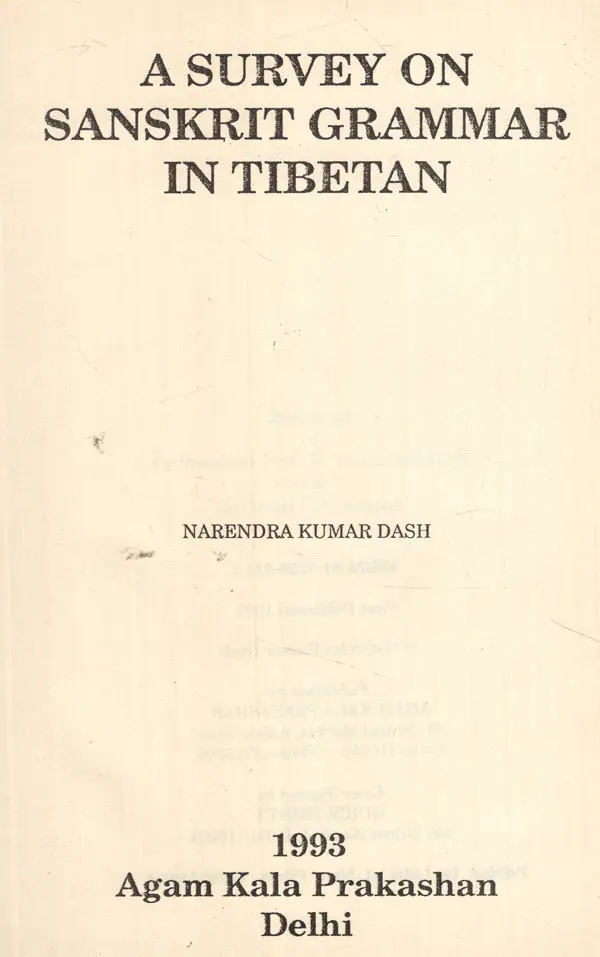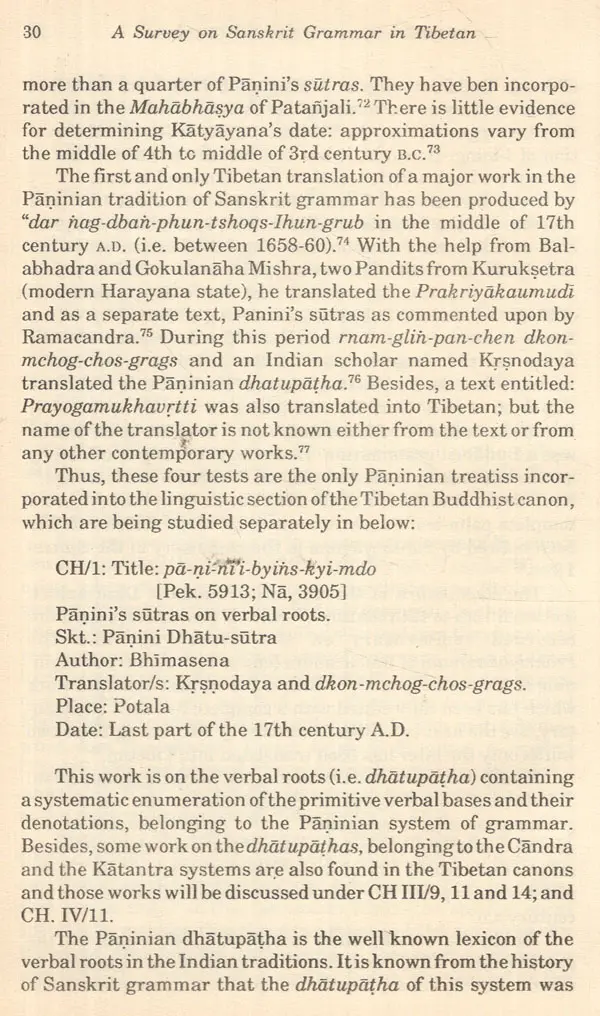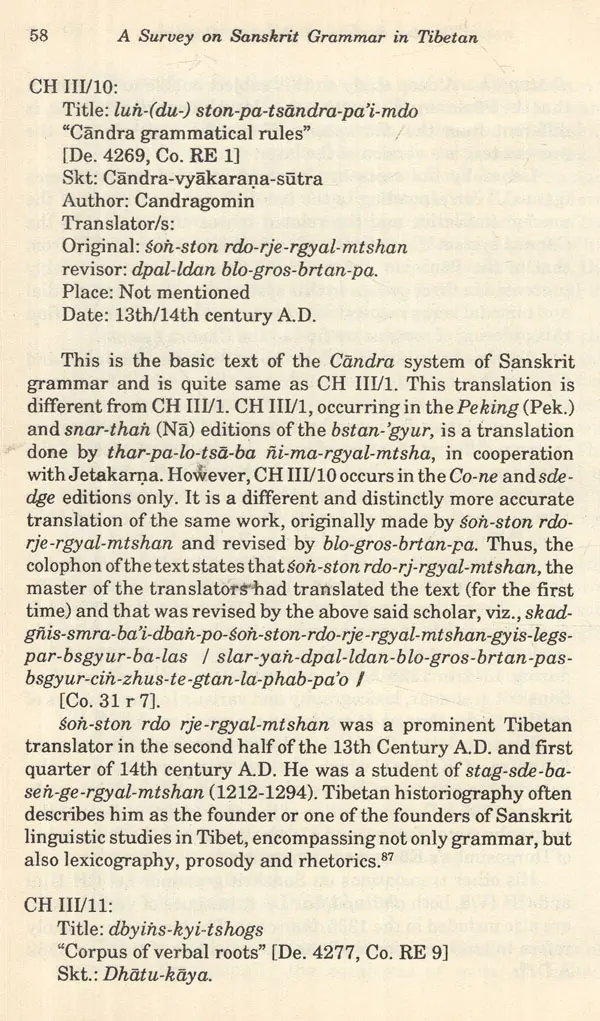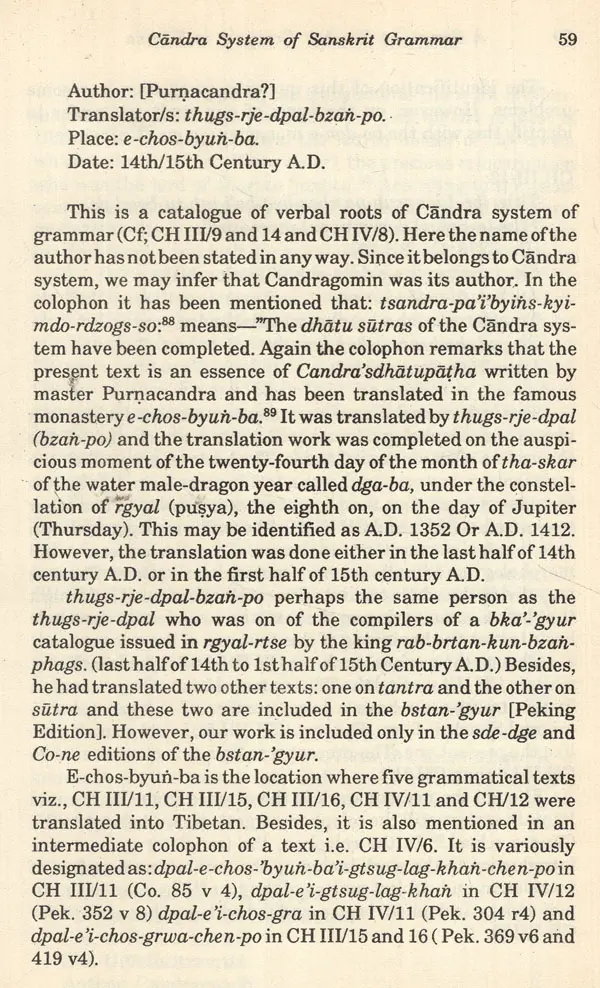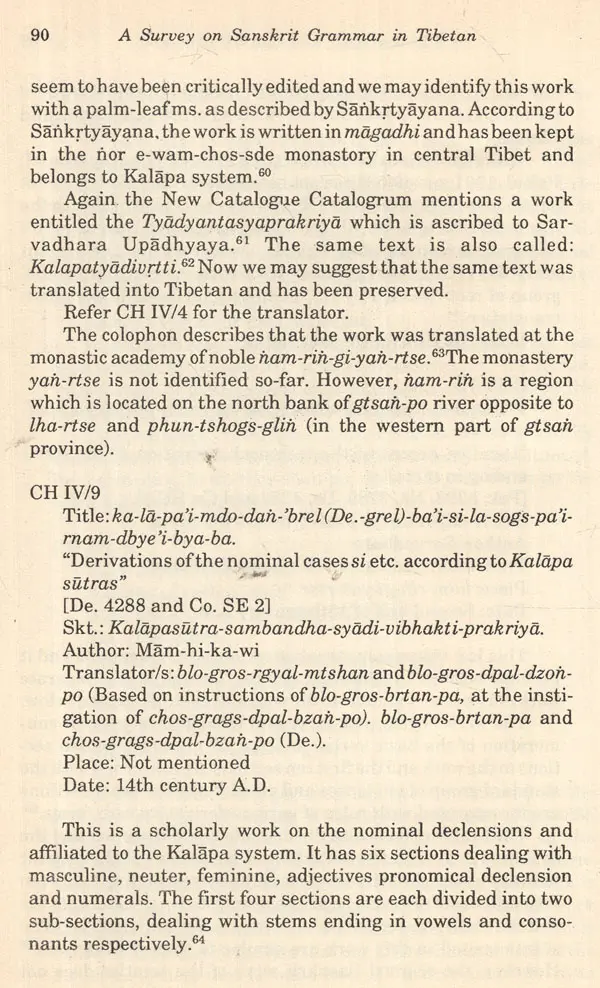
A Survey on Sanskrit Grammar in Tibetan (An Old and Rare Book)
Book Specification
| Item Code: | UAO395 |
| Author: | NARENDRA KUMAR DASH |
| Publisher: | Agam Kala Prakashan, Delhi |
| Language: | English |
| Edition: | 1993 |
| ISBN: | 8173200114 |
| Pages: | 165 |
| Cover: | HARDCOVER |
| Other Details | 9.00 X 6.00 inch |
| Weight | 340 gm |
Book Description
Buddhism first spread in Tibet during the time of the Tibetan royal empire (mid seventh century to mid-ninth Century A.D.). During this period the Sanskrit studies began in Tibet; the translation activities reached the peak the Indo Tibetan translaion-literature was codified and canonized. Later the majority of translations of Indic Buddhist treatises were codified in Tibetan Buddhist canon i.e. the Bka'-'gyur and Bstan-'gyur text collections.
The four versions of the Bstan-'gyur suggest that forty-seven Sanskti Gram martical texts were translated into Ti betan by the joint effort of the Indian and Tibetan scholars. These works may be divided into five grammatical schools i.e. Panini, Candra, Kalapa or Kätantra, Sarasvata and Mañjuśri. While the first four schools are quite popular in India, the fifth one is obscure in Indian grammatical tradition.
The present treatise has seven chapters and the beginning chapter is incorporated with a study on the ninth-century work Sgra-sbyor-bam-po-gnis pa. There it has been mentioned that how elements form the Indian traditions of linguistic descrip tion are merely subservient to the develop ment and perfection of the Tibetan trans lating-techniques.
In the next six chapters all the forty seven manuscripts have been analysed and in each case the life history of the translator is given and the geographical location of the place of translaion has been identified.
Thus, the present work deals with a critical study of the grammatical works which are preserved in the Bstan-gyur and the work is first of its kind.
Dr. Narendra Kumar Dash (b. 1960, Dharmasala, Cuttack), obtained his Shastri Degree in Vyakarana with merit from Rastriya Sanskrit Sansthan (1982) and Master Degree in Sanskrit from Visva Bharati, Santiniketan (1984). He worked for his Doctoral thesis as a U.G.C. (NET) fellow in the said University and was awarded Ph. D. Degree (1990) for his dissertation on the Paribhāṣāvṛtti of Purusottamadeva.
Dr. Dush, basically a Sanskrit scholar, but has sound knowledge on Assamese, Bengali, Hindi, Oriya, Prakrit and Tibetan languages. At a young age he has written twenty research papers on various aspect of Linguistic, Religion and Philosophy. With first hand knowledgge of the original sources from Sanskrit and Tibetan litera ture, Dr. Dash's writtings present deep in sight and original thinking. Two published. works: "Purusottamadeva As Grammarian and An Encyclopaedic Dictionary of Indian Culture have been written by the author.
At present the author is working on Sanskrit grammatical works which were translated into Tibetan in between 11th century A.D. to 18th century and obscure in the history of Sanskrit grammar.
Buddhism first spread in Tibet during the time of the Tibetan royal empire (mid-seventh century to mid-ninth century A.D.) which produced the majority of translations of Indian Buddhist treatises and the codification of this literature in Tibetan Buddhist canon, consisting of the bka-gyur and bstan 'gyur text-collections. During this period the political power in Tibet rested in the hands of the sa-skya-pa sect and a related dynasty in gtsan province.
The third phase (sixteenth to eighteenth century A.D.) corresponds to the dge-lugs-pa sect. Their spiritual leader was the head of the Tibetan state from the mid-seventeenth century onwards. Their political power was initially strengthened by their close ties with Mongol Kings, particularly the Manchu dynasty.
During these three phases there are clear close indications that the Tibetan rulers acted as patrons to the Sanskrit studies in Tibet. The study of Indic lingustic disciplines mainly carried out in connection with the creation of the Indo-Tibetan trans laion-literature. The Tibetan King's patronage of the Sanskrit studies inthe first phase helped considerably in formation of the Central Committee of Translators which was responsible for revision and standardization of the translations and for the compilaiton of the normatic Sanskrit-Tibetan lexicon the Mahāvyutpatti and its commentary entitled sgra-sbyor-bam-po gnis-pa. In the latter book various aspects of Sanskrit grammar were included. In the next two phases the politically dominant sects-the sa-skya-pa and dge-lugs-pa were strong factors in the development of Sanskrit grammatical studies in Tibet. They were the only sects engaged in learning the Sanskrit Grammar. The contribution of the dge-lugs-pa sect to the development of Sanskrit linguistic studies lies mainly in the activities of the Fifth Dalai Lama Nag-dban-blo-bzan-rgya-mtsho (1617-1682) and his regent Sde-srid-sans-rgyas-rgya-mtsho (1653-1705) both of them were responsible for an important revival of interest in various Indian art and sciences.
Buddhism was established in Tibet during the reign of king sroh-btsan-sgam-po in early 7th century A.D.' The king belonged to the yar-lun dynasty, originally a clan of local chieftains in the yar-luh valley, south of the gtsan-po river, which only briefly before his ascension had acquired the allegiance of several neighbouring clans, thus forming a confederation that would lead to the first more or less centralized authority over central Tibet. Under his rule the Tibetan State rose to sub power and extent of territory in Central Asia that is became an Empire. For more than two hundred years this dynasty managed to maintain the centralized authority over Tibet.
The first spread (sha-dar) of Buddhism in Tibet taken place during this period of Tibetan Empire, from early seventh cen tury to mid-ninth century A.D. Not all kings of the said dynasty were well disposed towards Buddhism, some favoured the local animistic cults generally indicated with the technical term bon the king's allegiance to either Buddhism or bon being a major political factor in the fluctuating play of power among the clans of Tibetan nobility.
A close study of the history of Tibet suggest that three kings have contributed most strongly to the propagation of Buddhism in Tibet. They were: Sron-btsan-sgam-po, mentioned above, khri-sron-lde-btsan (last quarter of 8th century A.D.), during whose reign Tibetan power reached its apogee, and khri-gtsug Ide-btsan ral-pa-can (1st half of 9th century A.D.). During the reign of the king Khri-lde-sron-btsan sad na legs, the immediate predecessor at khri-gtsug-Ide-btsan ral-pa-can, Buddhism emerged as a significant political power for the first time in Tibet.
Book's Contents and Sample Pages
